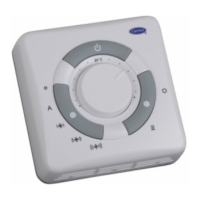PG80VTLA: Installation, Start-up, Operating and Service and Maintenance Instructions
Manufacturer reserves the right to change, at any time, specifications and designs without notice and without obligations.
26
vent connector capacity is equal to or lower than the low fire rate of
the furnace and the FAN-Max vent connector capacity is equal to or
higher than the furnace high fire rate.
3. Do not vent this Category I furnace into a single wall dedicated or
common vent. The dedicated or common vent is considered to be
the vertical portion of the vent system that terminates outdoors.
4. Vent connectors serving Category I furnaces shall not be connected
into any portion of a mechanical draft system operating under
positive pressure.
5. Do not vent this appliance with any solid fuel burning appliance.
6. Category I furnaces must be vented vertically or nearly vertically
unless equipped with a listed mechanical venter. See SIDEWALL
VENTING section.
7. Do not vent this appliance into an unlined masonry chimney. (Refer
to Chimney Inspection Chart, Fig. 37).
A10133
Fig. 37 – Chimney Inspection Chart
Masonry Chimney Requirement
NOTE: These furnaces are CSA design-certified for use in exterior
tile-lined masonry chimneys with a factory accessory Chimney Adapter
Kit. Refer to the furnace rating plate for correct kit usage. The Chimney
Adapter Kits are for use with ONLY furnaces having a Chimney Adapter
Kit number marked on the furnace rating plate.
If a clay tile-lined masonry chimney is being used and it is exposed to
the outdoors below the roof line, relining might be required. Chimneys
shall conform to the Standard for Chimneys, Fireplaces, Vents, and Solid
Fuel Burning Appliances ANSI/NFPA 211 in the United States and must
be in good condition.
U.S.A.-Refer to Sections 13.1.8 and 13.2.20 of the NFPA 54/ANSI
Z223.1 or the authority having jurisdiction to determine whether relining
is required. If relining is required, use a properly sized listed metal liner,
Type-B vent, or a listed alternative venting design.
NOTE: See the NFPA 54/ANSI Z223.1 13.1.9 and 13.2.20 regarding
alternative venting design and the exception, which cover installations
such as our Chimney Adapter Kits which are listed for use with these
furnaces. See Product Data Sheet for accessory listing.
The Chimney Adapter Kit is a listed alternative venting system for these
furnaces. See the kit instructions for complete details.
This furnace is permitted to be vented into a clay tile-lined masonry
chimney that is exposed to the outdoors below the roof line, provided:
1. Vent connector is Type-B double-wall, and
2. This furnace is common vented with at least 1 draft hood equipped
appliance, and
WARNING
!
CARBON MONOXIDE POISONING HAZARD
Failure to follow the steps outlined below for each appliance connected
to the venting system being placed into operation could result in carbon
monoxide poisoning or death.
The following steps shall be followed for each appliance connected to
the venting system being placed into operation, while all other
appliances connected to the venting system are not in operation:
1. Seal any unused openings in venting system.
2. Inspect the venting system for proper size and horizontal pitch,
as required in the National Fuel Gas Code, NFPA 54/ANSI
Z223.1 and these instructions. Determine that there is no
blockage or restriction, leakage, corrosion and other
deficiencies, which could cause an unsafe condition.
3. As far as practical, close all building doors and windows and all
doors between the space in which the appliance(s) connected to
the venting system are located and other spaces of the building.
4. Close fireplace dampers.
5. Turn on clothes dryers and any appliance not connected to the
venting system. Turn on any exhaust fans, such as range hoods
and bathroom exhausts, so they are operating at maximum
speed. Do not operate a summer exhaust fan.
6. Follow the lighting instructions. Place the appliance being
inspected into operation. Adjust the thermostat so appliance is
operating continuously.
7. Test for spillage from draft hood equipped appliances at the
draft hood relief opening after 5 minutes of main burner
operation. Use the flame of a match or candle.
8. If improper venting is observed during any of the above tests,
the venting system must be corrected in accordance with the
National Fuel Gas Code, NFPA 54/ANSI Z223.1.
9. After it has been determined that each appliance connected to
the venting system properly vents when tested as outlined
above, return doors, windows, exhaust fans, fireplace dampers
and any other gas-fired burning appliance to their previous
conditions of use.
CHIMNEY INSPECTION CHART
For additional requirements refer to the National Fuel Gas Code NFPA 54/ANSI Z223.1 and ANSI/NFPA 211
Chimneys, Fireplaces, Vents, and Solid Fuel Burning Appliances
Consult
Par t C of
chimney adapter venting
instructions for
application
suitability
Is chimney
lined with properly
sized, listed liner or
Type-B vent?
Is chimney
to be dedicated to
a single
furnace?
Chimney
exposed to
outdoors below
roof line?
Repair
liner or top seal
or reline chimney as
necessary.
Mortar
or tile
debris?
Clay
tile misalignment,
missing sections,
gaps?
Debris
in cleanout?
Mortar, tile, metal vent,
fuel oil residue?
Is
liner and top
seal in good
condition?
Is chimney
property lined with
clay tile liner?
Crown
condition:
Missing mortar
or brick?
Rebuild
crown.
Ye s
Ye s
No
No
No
Reline
Ye s
Repair
Ye s
Ye s
Ye s
No
No
Remove mortar
and tile debris
Remove metal vent
or liner.
No
No
No
No
Ye s
Ye s
Suitable
Suitable
Not Suitable
Line chimney with property
sized, listed flexible metal
liner or Type-B vent per
NFGC
Vent
Sizing Tables and liner or
vent manufacturer’s
Installation instructions.
Install chimney
adapter per
instructions.
Chimney is
acceptable for use.
Install chimney
adapter per
instructions.
Consult
Par t B of
chimney adapter venting
instructions for
application
suitability.
Ye s
Not Suitable
Condensate
drainage at bottom
of chimney?
Ye s
No

